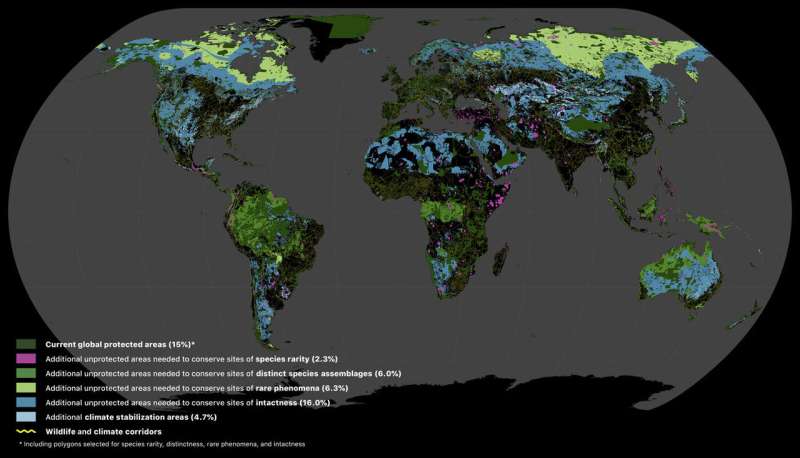Areas of the terrestrial realm where increased conservation action is needed to protect biodiversity and store carbon. Numbers in parentheses show the percentage of total land area of Earth contributed by each set of layers. Unprotected habitats drawn from the 11 biodiversity data layers underpinning the Global Safety Net augment the current 15.1% protected with an additional 30.6% required to safeguard biodiversity. Additional CSAs add a further 4.7% of the terrestrial realm. Also shown are the wildlife and climate corridors to connect intact habitats (yellow lines). Data are available for interactive viewing at www.globalsafetynet.app . Credit: Science Advances (2020). DOI: 10.1126/sciadv.abb2824
An international team of researchers has created an online platform called the Global Safety Net. It uses global maps to show which land areas need to be protected in order to safeguard biodiversity and stem carbon emissions. In their paper published in the journal Science Advances, the group describes their project, their goals and the maps they created.
As the planet continues to warm, posing a threat to future generations, and as the global pandemic continues to infect millions around the world, other serious threats have received less notice. One such threat is the loss of natural land. The rain forests are still being cut down, and large pieces of natural wilderness continue to be lost as farmers, miners, loggers and homesteaders move in. Such losses not only represent possible extinction of the creatures that live in such areas, but also an opportunity to prevent further global warming. Most natural habitats store a lot of carbon. In this new effort, the researchers have created interactive maps and posted them online that graphically depict which parts of the land areas on planet Earth need to be conservation if we are to have any hope of preserving biodiversity—and in the process, stem the growth of carbon emissions.
The maps show land areas that are already under protection laws. From there, they allow users to add incremental land areas that represent different areas of protection. Users can see which land areas need to be protected, for example, to protect species at risk of extinction. Other options include color-highlighting areas that should be set aside to protect rare species or phenomena. And still others allow for highlighting large tracts of land that need to be set aside to preserve large animals like big cats in South America or caribou in northern regions.
The goal of the initiative is to increase awareness of the steps that humans can take to preserve natural areas before it is too late—and hopefully, to gain support for doing so.
More information: E. Dinerstein et al. A "Global Safety Net" to reverse biodiversity loss and stabilize Earth's climate, Science Advances (2020). DOI: 10.1126/sciadv.abb2824
Journal information: Science Advances
© 2020 Science X Network
























